The Job of a Veterinary Assistant: Is It the Right Career for You?

The role of a Veterinary Assistant is a vital one within the veterinary industry, providing support to veterinarians and veterinary technicians in the care of animals. This profession requires a passion for animals, physical ability, technical skills, and excellent communication and multitasking abilities.
In this article, we will explore the qualifications and typical tasks of a Veterinary Assistant, as well as ways to increase income and opportunities for career advancement. We will also discuss the education and certification options available and explore the different career paths within the veterinary industry, as well as alternative career paths. Additionally, we will provide an overview of the job outlook and flexible work arrangements available for Veterinary Assistants, as well as the pros and cons of working in this profession. Finally, we will highlight several government programs available in the US to support and train individuals interested in becoming Veterinary Assistants.
Position Overview
A Veterinary Assistant is a professional who works in a veterinary clinic or hospital, supporting the veterinarian and veterinary technicians in the care of animals. Their responsibilities may include assisting with animal exams, feeding and exercising animals, administering medication, and cleaning and maintaining animal cages and equipment. They may also interact with pet owners and help with client communication and education. Veterinary Assistants may have on-the-job training or may have completed a certificate or diploma program in veterinary assisting.
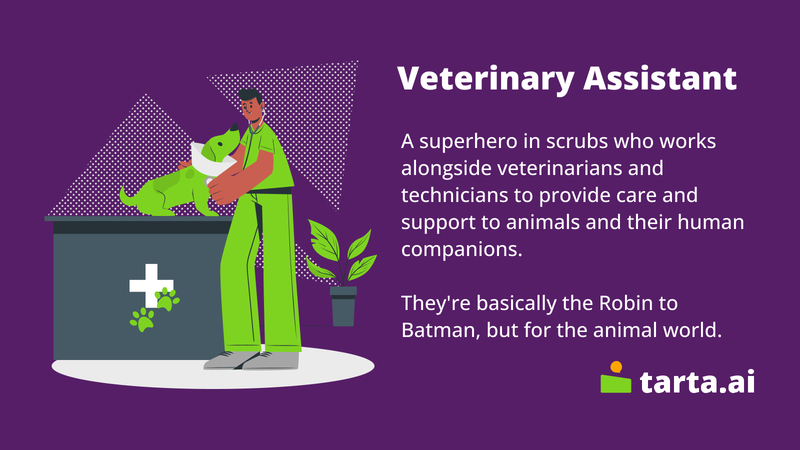
Key Qualifications
The key qualifications for a Veterinary Assistant may include:
- Passion for animals: A Veterinary Assistant must love and be passionate about animals. They should be able to handle animals with care and compassion.
- Physical ability: The job of a Veterinary Assistant requires physical labor, such as lifting animals, cleaning cages, and restraining animals during procedures.
- Communication skills: Veterinary Assistants need to communicate with pet owners, veterinary staff, and other animal care professionals. They should be able to communicate effectively and respectfully.
- Attention to detail: Veterinary Assistants need to be detail-oriented in order to follow instructions from veterinarians and ensure that procedures are carried out correctly.
- Multitasking ability: A Veterinary Assistant may have to perform multiple tasks at the same time, such as answering phones while caring for animals.
- Technical skills: Basic computer skills, data entry, and record-keeping are often required in veterinary clinics.
- Willingness to learn: A Veterinary Assistant must be willing to learn and keep up-to-date with new treatments, medications, and procedures in veterinary medicine.
- Empathy: Veterinary Assistants should have empathy and the ability to comfort pets and pet owners during stressful situations.
- Ethics and professionalism: Veterinary Assistants should adhere to ethical and professional standards when handling animals and dealing with clients.
Interesting fact:
The global veterinary market size is expected to reach $73.4 billion by 2027, driven by the increasing demand for pet care and animal health products.
Tasks and Expectations
The tasks and expectations for a Veterinary Assistant may vary depending on the veterinary clinic or hospital they work in, but some common responsibilities include:
- Assisting veterinarians and veterinary technicians with animal care procedures, such as administering medication, taking vital signs, and drawing blood.
- Cleaning and sterilizing animal cages, equipment, and exam rooms.
- Feeding, exercising, and providing basic care for animals in the clinic.
- Providing assistance to pet owners, such as answering questions and scheduling appointments.
- Monitoring and reporting on animal behavior, symptoms, and health conditions.
- Maintaining accurate and up-to-date records of animal care and treatments.
- Ordering and maintaining inventory of animal care supplies and medications.
- Restraint of animals for exams, procedures, and treatments.
- Assisting with surgical preparation and post-operative care of animals.
- Providing compassionate care to animals during their stay in the clinic.
In general, Veterinary Assistants are expected to work under the supervision of a veterinarian or veterinary technician, follow established protocols, maintain a clean and organized work environment, and provide excellent customer service to pet owners. They should also have strong attention to detail, be able to multitask, and work well in a team environment.
Compensation
The salary of Veterinary Assistants in the US can vary depending on a number of factors such as location, experience, and employer. According to data from PayScale, the median hourly wage for Veterinary Assistants is $14.30.
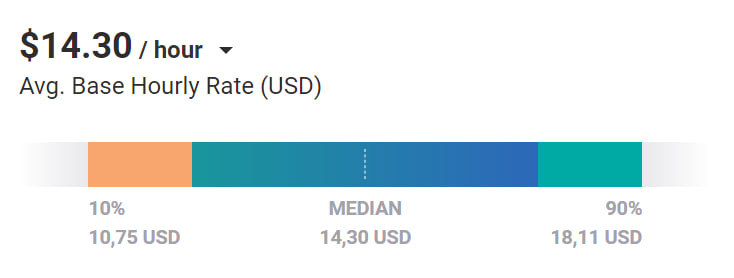
Source: PayScale
However, it's important to note that this is just a median value, and the annual salaries can range from around $22,000 to $38,000, depending on the factors mentioned above. Veterinary Assistants who work in larger metropolitan areas may earn higher salaries than those in more rural areas, and those with more experience or additional certifications may also earn more.
Strategies for Increasing Income
There are several ways that Veterinary Assistants can increase their income, including:
Strategy | Description |
Continuing education and training | Veterinary Assistants who pursue additional training and education in areas such as animal behavior, nutrition, or medical procedures may be able to take on more responsibilities and earn higher salaries as a result. |
Specializing in a particular area | Some Veterinary Assistants choose to specialize in areas such as surgical assistance, radiology, or dentistry, which can lead to higher salaries and increased job opportunities. |
Gaining experience | As with many careers, Veterinary Assistants who gain more experience in the field may be able to command higher salaries. |
Working in a higher-paying location | As mentioned earlier, Veterinary Assistant salaries can vary depending on location. Working in a larger metropolitan area or in a state with higher wages can result in higher salaries. |
Negotiating salary | When starting a new job or during annual performance reviews, it may be possible to negotiate a higher salary based on experience, education, and performance. |
Taking on additional responsibilities | Veterinary Assistants who take on additional responsibilities, such as managing inventory, training new employees, or performing administrative tasks, may be able to earn higher salaries as a result. |
Note:
While veterinarians are responsible for diagnosing and treating illnesses in animals, Veterinary Assistants provide essential support to ensure that animals are well-cared for and comfortable during their stay at a clinic or hospital.
Supplementary Perks
In addition to salary, there are a number of additional benefits that Veterinary Assistants may be eligible for, depending on their employer. Some of these benefits may include:
- Health insurance: Many employers offer health insurance to full-time employees, which can include medical, dental, and vision coverage.
- Retirement plans: Some employers offer retirement plans, such as 401(k) plans, which allow employees to save for their future.
- Paid time off: This may include sick days, vacation time, and holidays.
- Continuing education and training: Some employers may offer opportunities for Veterinary Assistants to attend conferences or workshops to further their education and training.
- Employee discounts: Veterinary Assistants may be eligible for discounts on pet products and services, as well as discounts at local businesses.
- Flexible schedules: Some employers offer flexible scheduling options, such as part-time or flexible hours, which can be beneficial for employees with other obligations.
- Career advancement opportunities: With additional education and experience, Veterinary Assistants may be able to advance to roles with higher salaries and more responsibilities.
It's important to note that benefits may vary depending on the employer and the individual's employment status (e.g. full-time vs. part-time).
Work Environment
In the following sections, we will explore different work environment settings, the tools and technologies commonly used by veterinary assistants in each setting.
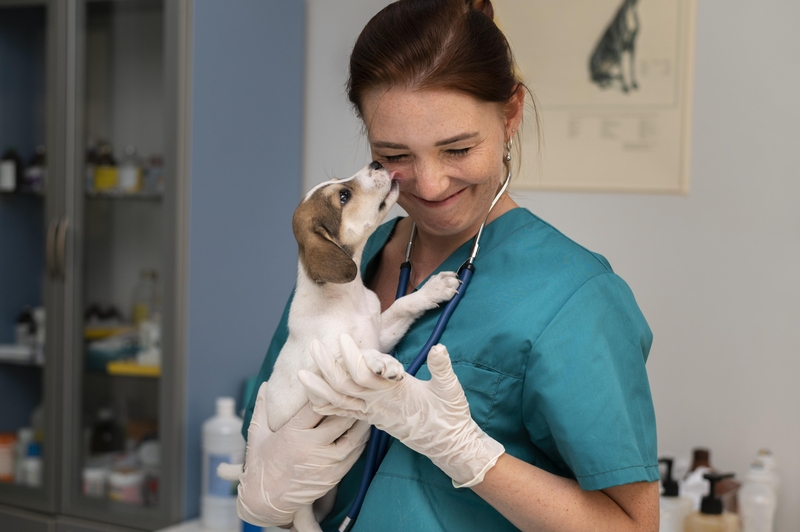
Photo: Freepik
Work Environment Settings
As a Veterinary Assistant, you will be working in a healthcare setting that primarily deals with animals. Here are some common work environment settings that you may encounter:
- Veterinary Clinic or Hospital: Most Veterinary Assistants work in a clinic or hospital setting, which typically consists of an exam room, treatment area, and surgery room.
- Animal Shelter: Some Veterinary Assistants work in animal shelters, where they assist with the care and treatment of animals that have been abandoned or rescued.
- Research Facility: A few Veterinary Assistants work in research facilities, where they assist with animal-related research projects.
- Mobile Clinic: In some cases, Veterinary Assistants may work in mobile clinics that travel to different locations to provide veterinary care to animals.
- Zoological Park or Aquarium: A small number of Veterinary Assistants work in zoos and aquariums, where they assist with the care and treatment of exotic animals.
Regardless of the setting, Veterinary Assistants must follow strict hygiene protocols to ensure the safety of both the animals and the humans working with them. This includes washing their hands frequently, wearing personal protective equipment (PPE) such as gloves and masks, and disinfecting surfaces regularly.
Note:
While dogs and cats are the most common pets that Veterinary Assistants work with, they may also care for exotic animals, such as birds, reptiles, and small mammals.
Tools and Technologies
As a Veterinary Assistant, you will use a variety of tools and technologies to assist in the care and treatment of animals. Here are some examples:
Tools and Technologies | Description |
Animal Handling Equipment | This may include leashes, collars, muzzles, and other tools to safely handle and restrain animals during exams, treatments, or surgeries. |
Diagnostic Equipment | Veterinary Assistants may use diagnostic equipment such as thermometers, stethoscopes, blood pressure monitors, and x-ray machines to assess an animal's health status. |
Cleaning Equipment | To maintain a sterile and safe environment, Veterinary Assistants use cleaning equipment such as disinfectants, mops, and vacuums. |
Medical Supplies | Veterinary Assistants may administer medication or fluids, provide wound care, or perform other medical procedures using syringes, needles, catheters, bandages, and other medical supplies. |
Computer Software | Many veterinary clinics use computer software to manage patient records, appointments, and billing. Veterinary Assistants may use these programs to input data, schedule appointments, or update patient information. |
Communication Tools | Veterinary Assistants often communicate with clients, veterinarians, and other staff members using phones, emails, or messaging software. |
It is essential for Veterinary Assistants to be proficient in the use of these tools and technologies, as they are critical to providing high-quality care to animals.
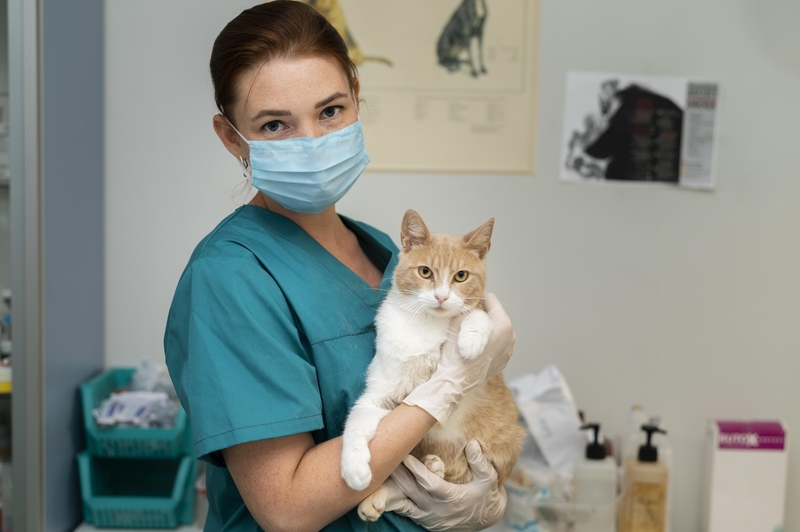
Photo: Freepik
Education and Training
Education and training for Veterinary Assistants typically involves a combination of classroom instruction and hands-on experience. Here are some of the key components:
- High school diploma: A high school diploma or equivalent is typically required to become a Veterinary Assistant.
- Certification: While not always required, many employers prefer to hire certified Veterinary Assistants. There are several certification programs available, such as the Approved Veterinary Assistant (AVA) program offered by the National Association of Veterinary Technicians in America (NAVTA).
- On-the-job training: Most Veterinary Assistants learn their skills on the job. They may be trained by veterinarians or more experienced Veterinary Assistants in tasks such as animal handling, basic care and feeding, and medical record keeping.
- Online courses: Many community colleges and vocational schools offer online courses in veterinary assisting. These courses may cover topics such as animal anatomy and physiology, medical terminology, and veterinary pharmacology.
Overall, the education and training for Veterinary Assistants is designed to provide a solid foundation in animal care and support the veterinarian in the clinical setting.
Interesting fact:
Some veterinary assistants specialize in certain areas, such as surgical or dental procedures, and may receive additional training in these areas.
Certification for Veterinary Assistants is a voluntary process, but it can be a valuable way to demonstrate knowledge and skills in the field. Certification programs typically involve a combination of education and experience requirements, as well as a certification exam.
There are several organizations that offer certification programs for Veterinary Assistants, including the National Association of Veterinary Technicians in America (NAVTA) and the American Animal Hospital Association (AAHA). These programs typically require a high school diploma or equivalent, as well as some amount of experience working with animals.
The certification exam for Veterinary Assistants typically covers topics such as animal care and handling, pharmacology, medical terminology, anatomy and physiology, and client communication. Some certification programs may also require the completion of continuing education courses or the demonstration of specific skills, such as venipuncture or radiography.
Certification can be a valuable asset when seeking employment as a Veterinary Assistant, as it demonstrates a commitment to the field and a level of knowledge and skill beyond that of a non-certified candidate. It may also provide opportunities for career advancement or increased earning potential.
Advancement Opportunities
In this section, we will explore the different levels of the Veterinary Assistant career ladder, the various specializations available in the veterinary industry, as well as alternative career paths for Veterinary Assistants outside of the veterinary field.

Photo: Werzk Luuuuuuu/Unsplash
Career Ladder for a Veterinary Assistant
As a Veterinary Assistant, there are several career advancement options available. Here is a possible career ladder for a Veterinary Assistant:
- Entry-Level Veterinary Assistant: This is the starting position for most individuals in the veterinary field. As an entry-level Veterinary Assistant, you will provide basic animal care, including feeding, cleaning, and monitoring animals. You will also assist veterinarians and veterinary technicians with procedures and treatments.
- Senior Veterinary Assistant: After gaining experience as an entry-level Veterinary Assistant, you may be promoted to a senior Veterinary Assistant. In this position, you will take on additional responsibilities such as supervising other Veterinary Assistants, training new staff members, and assisting with more complex procedures.
- Veterinary Technician: With additional training and education, you can become a veterinary technician. This typically involves completing a two-year associate degree program in veterinary technology. As a veterinary technician, you will have a higher level of responsibility and perform more advanced tasks, such as administering medication, performing lab work, and taking x-rays.
- Veterinary Technologist: With even more experience and education, you can become a veterinary technologist. This typically involves completing a four-year bachelor's degree program in veterinary technology or a related field. As a veterinary technologist, you will have more advanced skills and knowledge, and may have supervisory responsibilities over veterinary technicians and assistants.
- Veterinary Practice Manager: Another potential career path for Veterinary Assistants is to become a veterinary practice manager. This position involves managing the day-to-day operations of a veterinary practice, including staff management, scheduling, budgeting, and client relations. To become a veterinary practice manager, you may need additional education or experience in business or management.
- Veterinary Sales Representative: If you enjoy working with animals but prefer a more business-oriented role, you may consider becoming a veterinary sales representative. In this position, you will sell veterinary products and services to veterinary practices, animal hospitals, and other animal-related businesses. You will need strong sales skills and knowledge of veterinary products and services.
It's important to note that this is just one example of a career ladder for Veterinary Assistants. Depending on your interests, skills, and experience, there may be other career paths available to you within the veterinary field.
Interesting fact:
There were 99,350 veterinary assistants and laboratory animal caretakers employed in the United States.
Specializations in Veterinary Industry
The veterinary industry offers various specializations for individuals who wish to focus their career on a particular area of veterinary medicine. Here are some specializations within the veterinary industry:
Specialization | Description |
Veterinary Anesthesiologist | A veterinary anesthesiologist specializes in administering anesthesia to animals undergoing surgery or other medical procedures. They monitor vital signs and make adjustments to ensure the animal is safe and comfortable. |
Veterinary Behaviorist | A veterinary behaviorist specializes in diagnosing and treating behavioral issues in animals. They work with pets and their owners to develop behavior modification plans and may prescribe medications to treat underlying medical conditions. |
Veterinary Cardiologist | A veterinary cardiologist specializes in diagnosing and treating heart and cardiovascular issues in animals. They may perform procedures such as echocardiograms, electrocardiograms, and angiograms. |
Veterinary Dermatologist | A veterinary dermatologist specializes in diagnosing and treating skin, ear, and coat issues in animals. They may perform allergy testing, biopsies, and skin cultures. |
Veterinary Emergency and Critical Care Specialist | A veterinary emergency and critical care specialist provides immediate medical care to animals with life-threatening injuries or illnesses. They may work in emergency clinics or hospitals. |
Veterinary Internal Medicine Specialist | A veterinary internal medicine specialist diagnoses and treats internal medical issues in animals, such as kidney disease, liver disease, and cancer. They may use imaging technologies such as ultrasound and endoscopy to diagnose and treat these conditions. |
Veterinary Neurologist | A veterinary neurologist specializes in diagnosing and treating neurological issues in animals, such as seizures, spinal cord injuries, and brain tumors. They may perform procedures such as MRIs and CT scans. |
Veterinary Oncologist | A veterinary oncologist specializes in diagnosing and treating cancer in animals. They may perform biopsies, radiation therapy, and chemotherapy. |
Veterinary Ophthalmologist | A veterinary ophthalmologist specializes in diagnosing and treating eye and vision issues in animals. They may perform procedures such as cataract surgery, glaucoma treatment, and corneal grafts. |
Veterinary Surgeon | A veterinary surgeon specializes in performing surgeries on animals, such as orthopedic surgeries, soft tissue surgeries, and neurosurgeries. They may work in specialty clinics or hospitals. |
There are many other areas of specialization, such as veterinary nutrition, sports medicine, and rehabilitation.

Photo: FLOUFFY/Unsplash
Other Career Possibilities
Besides the career ladder within the veterinary industry, there are also other career options for Veterinary Assistants outside of the veterinary field. Here are some examples:
- Animal Shelter/Rescue Worker: As an animal shelter/rescue worker, you would provide care for animals in shelters or rescues. You may be responsible for cleaning and feeding animals, administering medications, and helping to find them permanent homes.
- Pet Groomer: As a pet groomer, you would provide grooming services for pets, such as bathing, trimming fur, and clipping nails. You may work in a grooming salon or pet store.
- Dog Walker/Pet Sitter: As a dog walker or pet sitter, you would provide care for pets while their owners are away. This could include walking dogs, feeding pets, and providing companionship.
- Veterinary Pharmaceutical Sales Representative: As a veterinary pharmaceutical sales representative, you would sell veterinary medications and products to veterinary practices, animal hospitals, and other animal-related businesses.
- Wildlife Rehabilitator: As a wildlife rehabilitator, you would provide care for injured or orphaned wild animals. This may involve providing medical care, feeding, and rehabilitation before releasing them back into the wild.
- Animal Control Officer: As an animal control officer, you would enforce animal-related laws and regulations, such as animal cruelty laws and leash laws. You may also be responsible for capturing and caring for stray animals.
- Research Technician: As a research technician, you would work in research facilities that use animals in their research. You would be responsible for providing care for the animals, assisting with experiments, and collecting and analyzing data.
- Zoological Park Technician: As a zoological park technician, you would provide care for animals in zoos, aquariums, and other wildlife parks. This may involve feeding, cleaning, and providing medical care for the animals.
These are just a few examples of career options for Veterinary Assistants outside of the veterinary industry. With the skills and experience gained as a Veterinary Assistant, you may find opportunities in a variety of animal-related fields.
Interesting fact:
According to the American Pet Products Association, nearly 70% of U.S. households have a pet, and spending on pets has been steadily increasing over the years.
Employment Trends
In this section, we will explore the job outlook for Veterinary Assistants in the United States, including the projected growth rate and the factors driving demand for this profession. Additionally, we will discuss the various flexible work arrangements available for Veterinary Assistants, which can provide greater work-life balance and job satisfaction. By understanding these aspects of the profession, individuals interested in pursuing a career as a Veterinary Assistant can make informed decisions about their education, training, and career goals.
Veterinary Assistant Demand
The job outlook for Veterinary Assistants in the United States is positive, with a projected growth rate of 19% from 2021 to 2031, according to the U.S. Bureau of Labor Statistics. This growth rate is much faster than the average for all occupations.
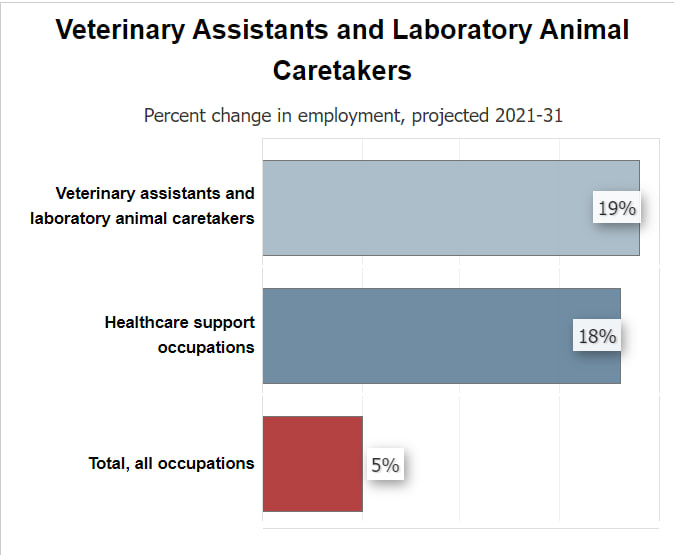
Source: U.S. Bureau of Labor Statistics, Employment Projections program
The demand for Veterinary Assistants is expected to increase due to the growing pet population and the need for veterinary practices to expand their services to meet the needs of pet owners. Veterinary Assistants are also in demand in research facilities, zoos, and other animal-related industries.
Additionally, as people become more concerned with the health and well-being of their pets, they are more likely to seek out veterinary care and services, which will increase the demand for Veterinary Assistants.
Overall, the job outlook for Veterinary Assistants in the US is positive, and there are many opportunities for those interested in pursuing a career in this field.
Flexible Work Arrangements
Flexible work arrangements for Veterinary Assistants:
- Part-time positions can allow Veterinary Assistants to work fewer hours and have a better work-life balance. This type of arrangement may be suitable for those who are studying or have other commitments, such as caring for family members.
- Remote work may also be an option for Veterinary Assistants, especially for administrative or customer service roles. This can provide greater flexibility and the ability to work from home or other locations.
- Flexible scheduling may allow Veterinary Assistants to work non-traditional hours, such as evenings or weekends, which can be convenient for pet owners who need to schedule appointments outside of normal business hours.
- Job sharing is another option where two or more people share one full-time position, dividing the responsibilities and workload. This arrangement can be beneficial for those who want to work part-time but still maintain a regular schedule and benefits.
There are various flexible work arrangements available for Veterinary Assistants, depending on their skills and preferences, and these options can help them achieve a better work-life balance and job satisfaction.
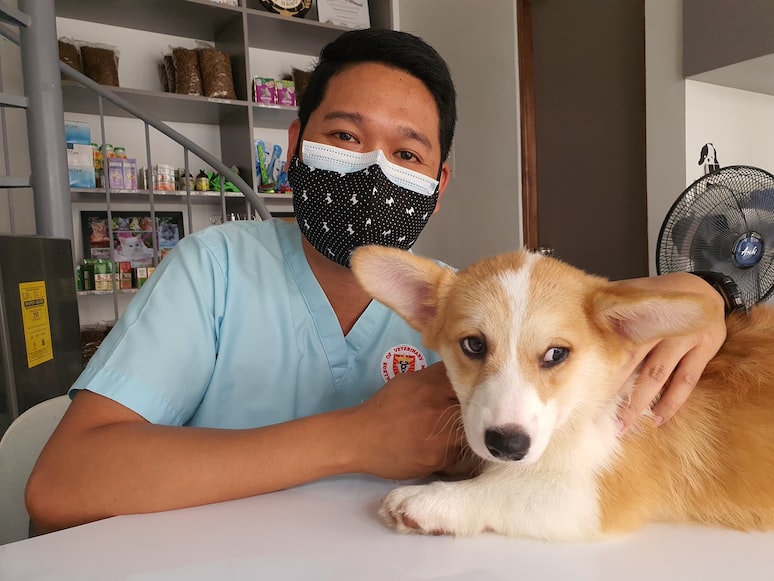
Photo: Karlo Tottoc/Unsplash
Job Fulfillment
The role of a Veterinary Assistant can be varied, and includes tasks such as providing assistance during surgeries, administering medication, performing laboratory tests, and handling animals. While working as a Veterinary Assistant can be rewarding, it also comes with its own set of challenges. In this section, we will discuss the pros and cons of being a Veterinary Assistant.
Pros | Cons |
Opportunity to work with animals Veterinary Assistants get to work with animals on a daily basis, which can be a fulfilling and rewarding experience. | Physical demands The job of a Veterinary Assistant can be physically demanding, as it often involves restraining animals and lifting heavy objects. |
Variety of tasks The job of a Veterinary Assistant can be quite diverse and includes tasks such as assisting with surgeries, taking x-rays, administering medication, and performing laboratory tests. | Emotional stress Dealing with sick or injured animals, as well as their owners, can be emotionally challenging for some Veterinary Assistants. |
Flexibility Many Veterinary Assistant positions offer flexible schedules, which can be beneficial for those with other commitments or responsibilities. | Low pay Veterinary Assistants may not earn as much as other healthcare professionals, which can make it difficult to make ends meet. |
Entry-level position Veterinary Assistant is an entry-level position, meaning that it can be a good starting point for individuals who are interested in pursuing a career in veterinary medicine. | Limited career advancement While there are opportunities for career advancement in veterinary medicine, the role of a Veterinary Assistant may not offer as many opportunities for advancement as other positions in the field. |
Learning opportunities Veterinary Assistants have the opportunity to learn about different animal species, diseases, and treatments, which can be a valuable experience. | Exposure to zoonotic diseases Veterinary Assistants may be exposed to zoonotic diseases, which can be transmitted from animals to humans, if they do not take proper precautions. |
Interesting fact:
The One Health initiative is a collaborative approach that recognizes the interconnectedness of human, animal, and environmental health. Veterinarians play an important role in this initiative by working to prevent and control zoonotic diseases (diseases that can be transmitted from animals to humans) and by promoting the health of animals and the environment.
Government Programs
There are several government programs in the US that can provide support and training for individuals interested in becoming Veterinary Assistants. Here are a few examples:
- Workforce Investment Act (WIA) - The WIA provides funding for job training and education programs. This program is administered by state and local governments and can be used to cover the cost of Veterinary Assistant training programs.
- Department of Veterans Affairs - The VA offers a range of education and training benefits for veterans and their dependents. This can include funding for Veterinary Assistant training programs.
- Apprenticeship Programs - Some states have apprenticeship programs for Veterinary Assistants. These programs are typically funded by the state government and provide on-the-job training and education.
- USDA Veterinary Medicine Loan Repayment Program - This program provides financial assistance to veterinarians who agree to work in underserved areas. Veterinary Assistants may be able to find employment opportunities in these areas and gain valuable experience.
- Animal Health Technician/Assistant Training Program - The US Department of Agriculture (USDA) offers a program that provides training to individuals who want to work as animal health technicians or assistants. The program is free and includes classroom instruction as well as hands-on training.
These are just a few examples of government programs that can provide support and training for Veterinary Assistants. It is important to research the specific programs available in your state or region to find the best fit for your needs.
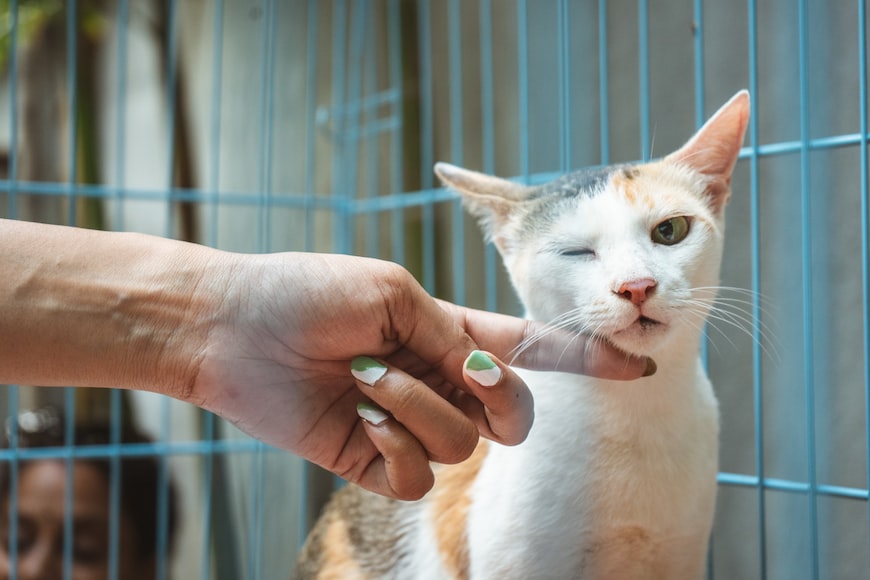
Photo: Kishore Ragav Ganesh Kumar/Unsplash
In conclusion, being a Veterinary Assistant is a rewarding and fulfilling career that requires a unique set of skills and qualities. As the demand for veterinary services continues to grow, the role of a Veterinary Assistant will become increasingly important. There are many opportunities for career advancement and specialization within the veterinary industry, as well as alternative career paths for those who wish to work with animals.
Pursuing education and certification can help individuals develop the knowledge and skills needed to provide high-quality care to animals and increase their income potential. Additionally, flexible work arrangements and government programs are available to support and train individuals interested in this profession. Ultimately, working as a Veterinary Assistant offers the opportunity to make a positive impact on the lives of animals and their owners while pursuing a fulfilling career.
- A Veterinary Assistant is a professional who works in a veterinary clinic or hospital, assisting veterinarians and veterinary technicians in the care of animals.
- Key qualifications for a Veterinary Assistant include a passion for animals, physical ability, communication skills, attention to detail, multitasking ability, technical skills, willingness to learn, empathy, and ethics and professionalism.
- Typical tasks and expectations for a Veterinary Assistant include assisting with animal care procedures, cleaning and sterilizing animal cages and equipment, feeding and caring for animals, providing assistance to pet owners, monitoring animal behavior and health, maintaining accurate records, ordering supplies, assisting with surgical preparation and post-operative care, and providing compassionate care to animals.
- Ways to increase income as a Veterinary Assistant include pursuing continuing education and training, specializing in a particular area, gaining experience, becoming certified, working in a higher-paying location, negotiating salary, and taking on additional responsibilities.
- The job outlook for Veterinary Assistants in the United States is positive, with increasing demand for veterinary services and flexible work arrangements available.
- The role of a Veterinary Assistant involves providing care and support for animals under the supervision of a licensed veterinarian, which can be a fulfilling and diverse job but also comes with physical demands, emotional stress, limited career advancement, and exposure to zoonotic diseases.
FAQ
What are some of the biggest challenges of working as a Veterinary Assistant?
Some of the biggest challenges of working as a Veterinary Assistant can include dealing with emotional or difficult clients, working with animals that are frightened or aggressive, and handling medical emergencies or unexpected situations.
What is the difference between a Veterinary Assistant and a Veterinary Technician?
While both Veterinary Assistants and Veterinary Technicians work in animal care, there are some key differences between the two roles. Veterinary Technicians typically have more education and training, and may perform more advanced medical procedures, such as administering anesthesia and performing dental cleanings. Veterinary Assistants typically provide more basic support, such as feeding and exercising animals and helping with routine medical procedures.
What kind of schedule can I expect as a Veterinary Assistant?
The schedule for a Veterinary Assistant can vary depending on the employer and the nature of the job. Many veterinary clinics and hospitals are open on weekends and holidays, so Veterinary Assistants may need to work these shifts as well.
How can I find a job as a Veterinary Assistant?
To find a job as a Veterinary Assistant, you can start by searching online job boards or contacting local veterinary clinics and hospitals directly. You may also want to consider obtaining certification as a Veterinary Assistant, as this can increase your chances of finding a job and demonstrate your commitment to the field.